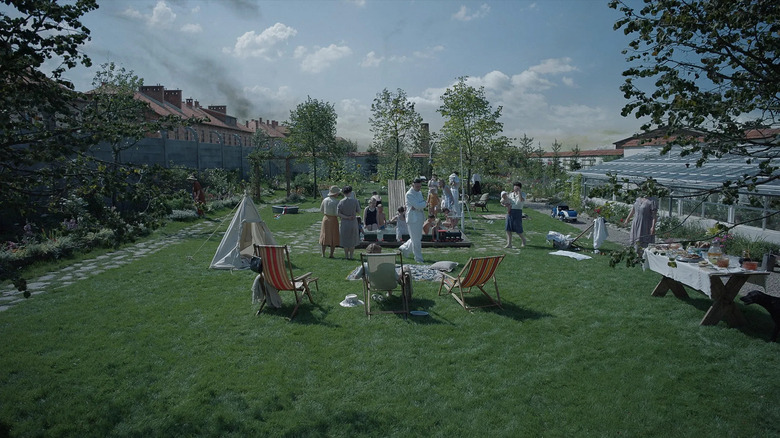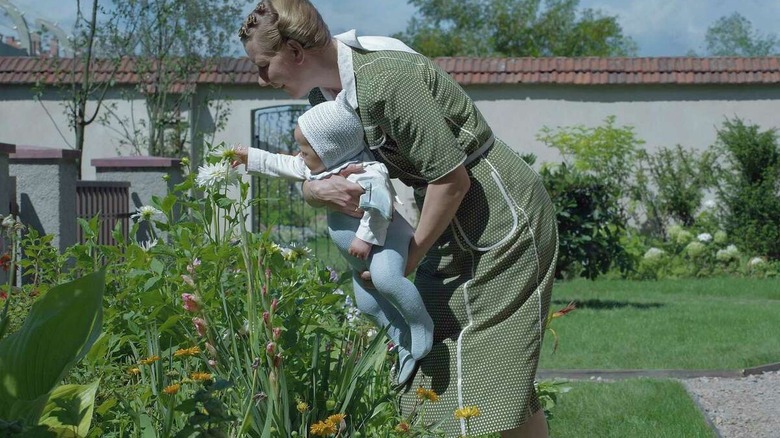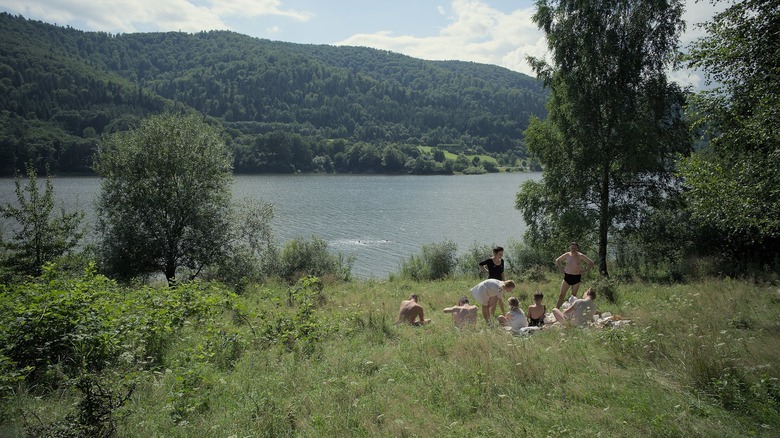The Zone Of Interest Ending Explained: Sanitizing A Home Of Evil
Spoilers follow.
Jonathan Glazer's "The Zone of Interest" takes place mostly in a pristine, clean two-story home in the Polish countryside. It has a large, verdant lawn, an outsize greenhouse, and spacious bedrooms for the occupants' children. Its garden is well-maintained and regularly fertilized. They have a small pool, even, equipped with a waterslide. People come to visit the manse's occupants regularly, and everyone comments on how nice it is, and how proud they are of Rudolf (Christian Freidel) and his wife Hedwig (Sandra Hüller) for maintaining such a lovely estate.
Sharing a wall with the estate is the Auschwitz concentration camp. It's the early 1940s and the smokestacks are billowing, belching out the ashes of hundreds upon hundreds of murdered Jews. During the day, Rudolf has meetings with other Nazi generals, discussing the logistics of how to use furnaces to dispose of human beings more efficiently. The Hades-like groan of deathly kill chambers hums gently in the background of every scene. Only very occasionally do Rudolf's and Hedwig's children hear a shout or a scream. Hedwig comfortably tries on a fur coat, recently taken from one of Auschwitz's victims. The kids play casually with collections of gold teeth.
Glazer keeps his camera back from the action, depicting a series of well-swept dioramas where evil lives. The bourgeois creature comforts held by Rudolf and Hedwig are specifically wielded to sanitize their moral emptiness and Rudolf's murderous job. It won't be until the end of the film that either Rudolf or Hedwig will reveal any moments of doubt or regret over their actions. Evil, it seems, can be reduced to comfortable living in posh homes, being concerned with lifestyle, and overlooking genocide. The banality of evil indeed.
The end
"The Zone of Interest" ends with Rudolf attending a fancy-dress ball with hundreds of glad-handing Nazi higher-ups, enjoying drinks and proud of the Reich. Rudolf feels detached. Earlier in the film, he received word that he may be transferred to another post, and he would lose his fancy house. Hedwig also hates this. He has been preoccupied with his military career. Rudolf sneaks away from the ball in the ballroom in an office building and finds a phone in a nearby office to call his wife. He admits that his mind has become a little too professionally geared, as he began wondering the logistics of gassing the ballroom and killing everyone in it. Hegwig says she needs to go to bed and hangs up.
Rudolf walks out of the office and begins descending a staircase. He vomits several times on the way down. He makes a mess, leaving his personal spillage on the otherwise pristinely sanitized floors. It's the one moment he seems to sense — even if he doesn't consciously acknowledge it — that what he is doing is horrible.
One might recall the ending of Joshua Oppenheimer's 2012 documentary "The Act of Killing," a film about the military takeover of Indonesia, and the mass murders it entailed. Years later, the military insurrectionists were still in charge. Oppenheimer interviewed them about the slaughter, and his findings were a shocking look into the mind of a fascist. The murderers liked to see themselves as "hero gangsters" out of an American movie (they're asked to make fictionalized movies of their lives).
The ending of "The Act of Killing" was clearly an inspiration for Glazer's "The Zone of Interest," something he talked about in a recent Q&A.
Parallels to The Act of Killing
"The Act of Killing" film ended with one of the gangsters, describing the way he would kill dozens and dozens of people (using twisting wires), finally succumbing to panic and dry heaves. He seems to all at once understand the violence. Drill deep enough, and a pang of conscience may still exist.
At a Q&A for "The Zone of Interest," Glazer acknowledged the similarities, saying:
"I saw 'The Act of Killing' during this process of writing this script and researching and so on, and so I saw the real evidence of that, which of course was extraordinary to see, having thought that might be how I was going to end the film. And I asked Christian to vomit in the scene. We tried to plan for him to vomit and take something that would make him vomit [...] but he didn't want to do that. So he just rejected that idea, and I understand why — he just was frightened of it."
Glazer noted that the vomit was a central symbol of the Rudolf character. While making the movie, Glazer would sketch images, only thematically connected to the subject matter of his movie. When he sketched a vomit scene, Rudolf became clear. Glazer noted:
"For me, that scene began with me trying to understand, trying to picture him at the end of his life. All the worthlessness of a particular life. And I remember doing a sketch of a pair of shoes and a pile of vomit. At the base of a pair of shoes [was] a pile of vomit, and I thought, 'Well, that's him.' So I always had that in mind that somehow that would be rendered."
A man only capable of upchucking. The organic world rejects him.
No salvation
Glazer also noted that Rudolf and Hedwig and the many, many Nazi generals who devoted their lives to the extermination of other human beings are the very essences of evil. There was no way, Glazer said, to redeem them. He said:
"[T]hese characters have no arc. There's no conscience, there's no salvation, there's no redemption, there's nothing. They're flat. They're a flat line. But I wanted evidence of the body rejecting the man somehow. How we delude ourselves with our minds, but our bodies tell the truth. So there's something in the truthfulness of that rejection and the horror, the inner horror, that made sense to me."
While Glazer wielded cleanliness and sanitization and upper-class comforts to cover up the evil of the Nazi party, he also filmed an epilogue that depicts how 21st-century historians have been using sanitization and cleanliness as an act of remembrance. While Rudolf is vomiting in a darkened hallway, Glazer makes a hard cut to the present-day Auschwitz, now turned into a museum and a memorial. He shows the museum employees vacuuming the floors, unlocking the cells, and cleaning off the glass that houses piles of victims' personal effects. The horrors of World War II are neatly packed into gleaming white boxes, presenting death in stark relief.
Glazer, however, is not cleaning up history, nor are the curators of the Auschwitz museum. They are cleaning up the area around the vomit, showing that evil is present. This is where the last scrap of humanity was spewed up and splattered on the ground. This is what genocide looks like. People once wore these clothes. Then they were killed. Look at death without distraction.
The Nazis cleaned up after their evil. We'll never be able to clean up after the Nazis.



